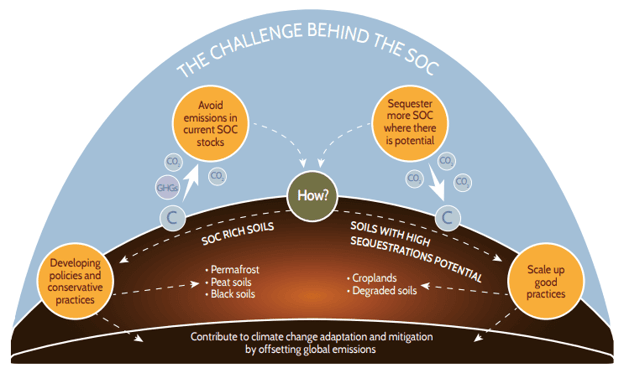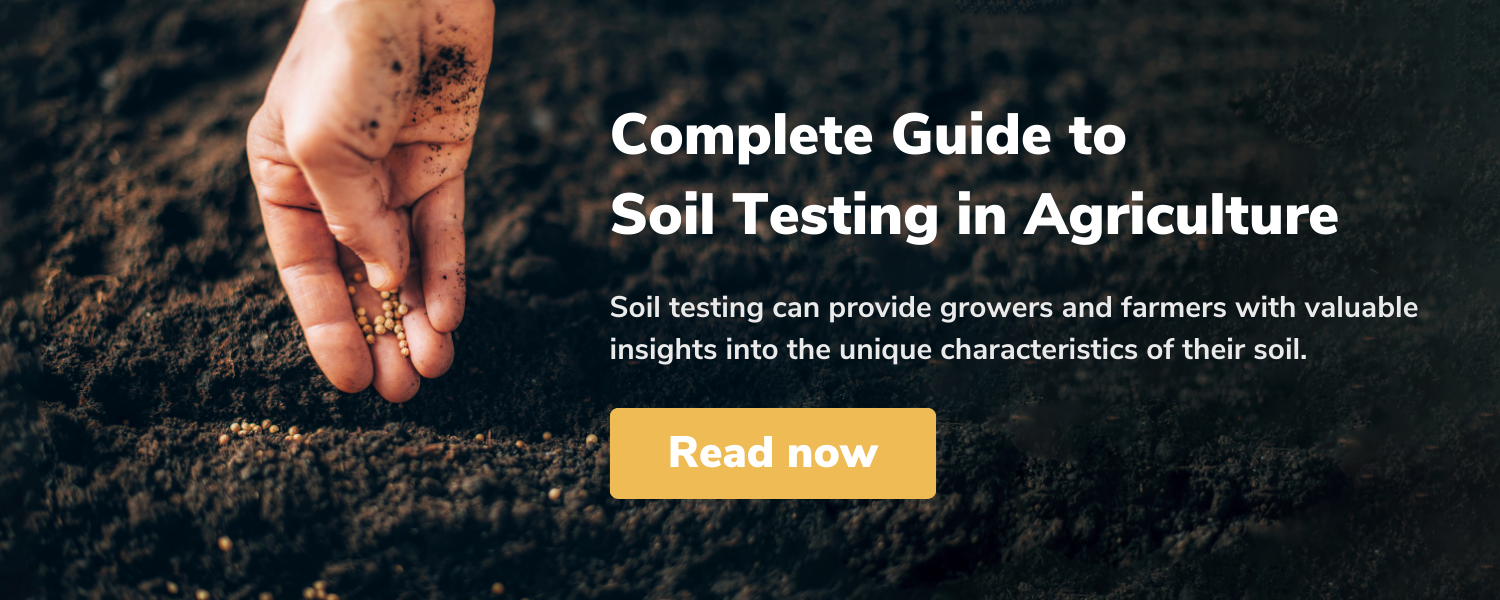Share this
Understanding Soil Carbon Sequestration in Agriculture
by Naz Hatay on 18/Apr/22
What is Carbon Sequestration?
Carbon sequestration describes the process of capturing and long-term storing of atmospheric carbon dioxide or other forms of carbon in plants, soils, geologic formations, and the ocean.
It has been proposed as a way to slow the atmospheric and marine accumulation of greenhouse gases in order to either mitigate or defer global warming and avoid the irreversible effects of climate change (1).
Carbon Sequestration Detection Methods
Depending on the method, carbon sequestration can take place through physical, chemical, or biological processes. Physical and chemical processes mainly involve absorption, adsorption, gas separation by membranes, and cryogenic distillation for CO2 capture (2). According to the book published by ASCE (American Society of Civil Engineer) “At present, the most commonly used CO2-capture technique is the use of chemical solvents such as methylaminoethanol (MAE) and many proprietary products''. [But] these processes have higher operating and capital costs, environmental risks, and technical restraints.”(3)
Capturing and sequestering carbon through biological processes, on the other hand, is a natural and cost-effective method. Biological carbon capture and sequestration (CCS) occurs through increased rates of photosynthesis via land-use practices.
Biosequestration has been incentivized by governmental bodies as a part of their climate change mitigation policies. Reforestation, sustainable forest management, and agroforestry are some examples of land management methods that sequester carbon on a large scale (4). Several have fewer risks and costs associated with them. Reforestation and sustainable land management cultivate strategic tree planting and restoration of once natural forested areas that were affected by urbanization. Agroforestry uses the four i’s: intentional, intensive, interactive, and integrative practices e.g., silvopasture, windbreaks, riparian buffers, food foresting, and alleycropping, where trees, crops, and/or livestock are integrated together. Implementing reforestation, sustainable forest management, and agroforestry can help increase global carbon capture by relying on trees' immense capability to store carbon and increase carbon in the soil.

Figure 1. FAO - Recarbonization of global soils
The process of capturing and storing atmospheric carbon dioxide via natural methods has also gained significant interest among researchers. Sedjo, R., and Sohngen, B., (2012) in their paper “Carbon Sequestration in Forests and Soils” (5), in which they focus on biological processes of carbon sequestration, state that “sequestration is possible through a range of processes, including those occurring naturally in plants and soils”(6).
The paper elaborates “In recent years, carbon sequestration and reduced emissions from avoided deforestation have received more attention as methods to help reduce the buildup of greenhouse gases in the atmosphere.”(7).
Furthermore, Kowalski et al. (2020), aiming to explain plant-soil interactions in soil organic carbon sequestration, have a whole chapter dedicated to carbon sequestration in soil (8). There, they identify: “afforestation of land (forest ecosystems), sequestration through the biosphere, proper cultivation of land (agriculture), peat bogs and peat, as well as fertilization of oceans” (9) to be the most important biological methods of carbon sequestration.
Carbon Sequestration Impact

Regardless of the methods of carbon sequestration, all conducted activities are aimed at active carbon sinking, and via this long-term removal process, atmospheric CO2 pollution could be reversed. But it is worth highlighting that, as a result of the incentives, along with its cost-effectiveness, biological carbon capture and sequestration have gained the interest of many stakeholders in the agriculture industry.
One example is the carbon farming initiative. This initiative helps farmers and landowners earn carbon credits for storing carbon or reducing greenhouse gas emissions (10) and emphasizes that the agricultural community can achieve environmental sustainability in the food supply chain (11). It is “an example of a new green business model”, as the policy document states (12).
Soil has the potential to be a powerful vehicle to sequester carbon, mitigate, and even reverse global warming. The rising interest in soil restoration initiatives could be a crucial avenue to reducing carbon emissions and empower long term storage underground.
Bibliography
(1) Rattan Lal, Wakene Negassa, Klaus Lorenz, Carbon Sequestration in Soil
https://doi.org/10.1016/j.cosust.2015.09.002. (https://www.sciencedirect.com/science/article/pii/S1877343515001013)
(2) Surampalli, R. Y., Zhang, T. C., Tyagi, R. D., Naidu, R., Gurjar, B. R., Ojha, C. S. P., Yan, S., Brar, S. K., Ramakrishnan, A., & Kao, C. M. (2015). Carbon capture and storage: Physical, Chemical, and Biological methods. American Society of Civil Engineers (ASCE).
https://doi.org/10.1061/9780784413678
(3) Rattan Lal, Wakene Negassa, Klaus Lorenz, Carbon Sequestration in Soil
https://doi.org/10.1016/j.cosust.2015.09.002. (https://www.sciencedirect.com/science/article/pii/S1877343515001013)
(4) National Academies Of Sciences, Engineering (2019). Negative Emissions Technologies and Reliable Sequestration: A Research Agenda. Washington, D.C.: National Academies of Sciences, Engineering, and Medicine. pp. 45–136. doi:10.17226/25259. ISBN 978-0-309-48452-7. PMID 31120708.
(5) Sedjo, R., & Sohngen, B. (2012). Carbon Sequestration in Forests and Soils. Annual Review of Resource Economics, 4(1), 127–144. doi:10.1146/annurev-resource-083110-115941
https://www.annualreviews.org/doi/abs/10.1146/annurev-resource-083110-115941
(6) ibid 5.
(7) Sedjo, R., & Sohngen, B. (2012). Carbon Sequestration in Forests and Soils. Annual Review of Resource Economics, 4(1), 127–144. doi:10.1146/annurev-resource-083110-115941
https://www.annualreviews.org/doi/abs/10.1146/annurev-resource-083110-115941
(8) Kowalska, A., Pawlewicz, A., Dusza, M., Jaskulak, M., & Grobelak, A. (2020). Plant–soil interactions in soil organic carbon sequestration as a restoration tool. Climate Change and Soil Interactions, 663–688. doi:10.1016/b978-0-12-818032-7.00023-0
https://www.sciencedirect.com/science/article/pii/B9780128180327000230?via%3Dihub
(9) ibid 8.
(10) https://www.agriculture.gov.au/water/policy/carbon-farming-initiative
(11) https://www.agriland.ie/farming-news/farms-that-remove-carbon-to-be-rewarded-under-new-eu-business-model/
(12) EU Commissions: A Farm to Fork Strategy for a fair, healthy and environmentally-friendly food system
https://ec.europa.eu/info/sites/info/files/communication-annex-farm-fork-green-deal_en.pdf
(13) Sedjo, R., & Sohngen, B. (2012). Carbon Sequestration in Forests and Soils. Annual Review of Resource Economics, 4(1), 127–144. doi:10.1146/annurev-resource-083110-115941
https://www.annualreviews.org/doi/abs/10.1146/annurev-resource-083110-115941
(14) Figure from FAO: Recarbonization of global soils
http://www.fao.org/3/ca6522en/CA6522EN.pdf
Originally published March 10, 2021, updated April 18, 2022.
Share this
- June 2025 (2)
- September 2024 (1)
- August 2024 (1)
- July 2024 (1)
- June 2024 (2)
- May 2024 (2)
- April 2024 (2)
- March 2024 (1)
- February 2024 (1)
- January 2024 (1)
- November 2023 (1)
- October 2023 (1)
- September 2023 (1)
- August 2023 (2)
- July 2023 (2)
- May 2023 (2)
- April 2023 (3)
- March 2023 (3)
- February 2023 (2)
- January 2023 (1)
- November 2022 (1)
- October 2022 (2)
- September 2022 (1)
- August 2022 (3)
- July 2022 (3)
- June 2022 (1)
- May 2022 (5)
- April 2022 (7)
- August 2021 (1)
- July 2021 (1)
- May 2021 (1)
- April 2021 (4)
- November 2020 (3)
- October 2020 (4)
- September 2020 (1)
- August 2020 (3)
- July 2020 (1)
- June 2020 (1)
- May 2020 (2)
